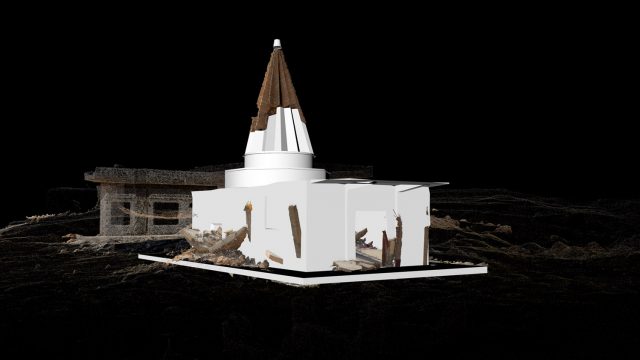The following is the lead catalogue essay for ‘A World of Fragile Parts’, the inaugural exhibition for the Pavilion of Applied Arts at the Venice Biennale, which was on display last year for the duration of the Architecture Biennale. The exhibition was curated by Brendan Cormier and Danielle Thom, and looked at how the V&A’s 19th century tradition of reproduction-making has taken on new meaning in the 21st century, as heritage sites are under increasing threat of destruction and damage, and as new digital reproduction and fabrication technologies promise alternative paths forward.
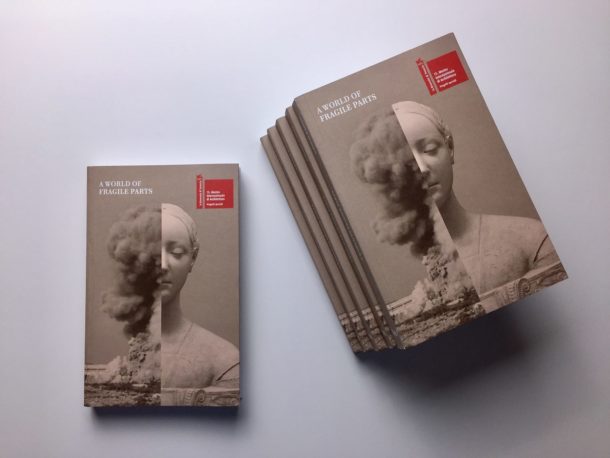
Against a Pile of Ashes
By Brendan Cormier
“We will keep this forever.” It’s the number one reason I usually give when trying to negotiate a museum acquisition. To the prospective donor, it takes a few seconds to sink in. An individual can imagine taking care of a personal collection during their lifetime, but after death you need to start relying on forces beyond your control—a committed grandchild, or a benevolent foundation. It’s feasible, but what about a hundred years down the line, or a thousand? When thinking in such timespans, donating to a museum, whose mandate is to keep things forever, suddenly sounds sensible.
A funny thing happens though when you consider a thousand years. You start to think just how fragile things really are. The truth is, nothing lasts forever. Textiles and works on paper, for instance, are doomed to gradually fade away simply from the presence of light. All a museum can do is slow that process. Peer into a conservation studio, and you’ll see a host of tricks geared to maintaining objects on a system of permanent life-support: skilfully inpainting damaged works of art; removing centuries of dust and grime from plaster work; adding structural support to weakened canvases; protecting against harmful encroachments of mould, chemicals, and other molecular threats. It is heroic work, but one that is fought against the greater force of time.
In matters of loss of cultural heritage, violence is the destructive force we are most accustomed to seeing. Images of ISIS invading and partially destroying historic structures of Palmyra in 2015, are likely still engrained in most of our minds. Equally present in the media cycle are natural disasters, earthquakes pummelling temples and historic sites across Nepal, flattening the city of Bam in Iran, or tsunamis ravaging the Japanese coastline. The prominence of these images remind us again and again of the fragility of our material world.
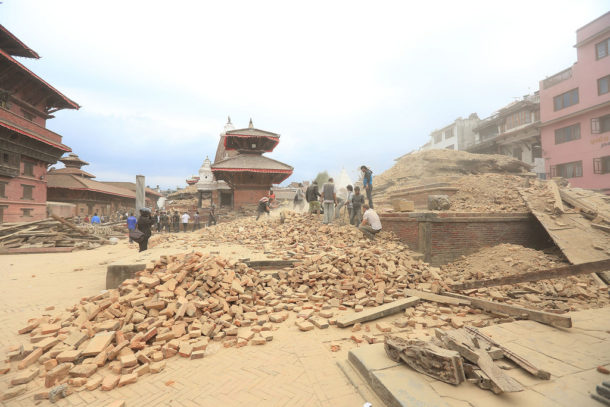
More insidious however are the soft factors wearing away at historic sites and objects: urbanization, tourism, accident, and neglect. Reported on less, they are undoubtedly more pervasive in their global destruction. There’s the case of the Greenpeace activists, for instance, who in 2014 irreversibly damaged Peru’s Nazca Lines, when they trespassed onto the site placing large yellow cloth letters that ironically read ‘Time for Change. The Future Is Renewable.’ There’s also the case of Tutankhamun’s tomb, where thousands of tourists visiting the site every year have triggered enough variation in humidity and carbon dioxide levels through their own breath to cause original painted plaster to crumble away. The stark reality is that small acts of destruction are happening every day in heritage sites and museums around the world.
Partly in reaction to this, the preservation industry has never been bigger. The more we uncover and recognize as important aspects of material culture, the greater the burden to preserve it. This sparks an increasingly urgent question: How much can we preserve in the face of unpredictable change?
Copies, the Same but Different
In this dire debate, copies are emerging as a potential answer. If all things eventually die, the only way to really preserve material culture, is to make them again, and again, and again. But copies are a contentious issue. Two thousand years ago, Plutarch raised the fundamental question, if a ship is gradually replaced with all its parts, is it still the same ship? And since then, we have been carefully re-tiling roofs, replacing doors and windows of our most treasured buildings, all in the name of preservation, while wondering at the same time if indeed ‘it’s still the same ship.’ Two millennia have passed since Plutarch yet the debate still continues, as evidenced by the case of the Buddhas of Bamiyan in Afghanistan. After they were destroyed by the Taliban in 2001, several organizations had pledged to rebuild it but other groups disagreed, worried that a rebuild would be inauthentic. ‘If you rebuild it, is it still heritage?’ has emerged as the preservation question today.
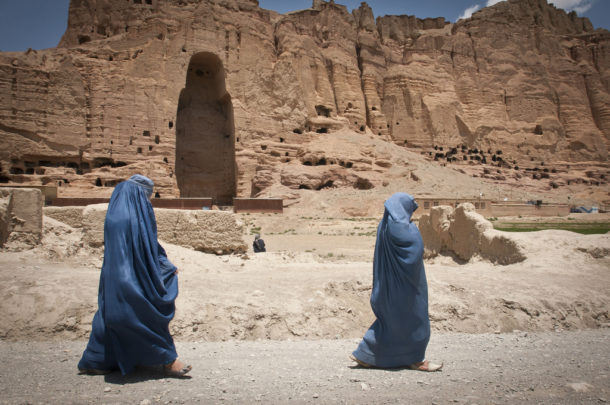
If a copy is offered as a replacement for a destroyed original it seems crass. But if a pre-existing copy happens to outlast its original it is declared a vital record of what was lost. A case in point can be found in the Cast Courts at the Victoria and Albert Museum. 150 years ago, the museum set about making large-scale plaster cast copies of works of art and architecture from around Europe and the world. It was the founding director Henry Cole’s conviction that the only way to get a British public to view the world’s great architectural treasures, was to bring those treasures to the people. Architecture generally being immovable, he commissioned detailed copies to be reassembled in South Kensington for the public to enjoy. Walk through the Cast Courts today, and you are confronted with one-to-one replicas of Trajan’s Column, the Portico de la Gloria from Santiago de Compostela, and Michelangelo’s David, among many others in a surreal mash-up of Western culture.
While these works were commissioned primarily out of a pragmatic question about serving an audience, they’ve now become prime examples of how copies can aid in preservation. Because these pieces have been cared for by conservators and sheltered from the elements for over a century, many have degraded far less than their originals. Trajan’s Column in Rome has been subject to air pollution and acid rain, while its duplicate at the V&A has not. Other copies in the collection have become sole survivors, as their originals were destroyed in one of the 20th century’s many wars. The casts also suggest another virtue—reducing the impact of tourism by offering alternative ways of seeing a work. Even though it’s easier than ever to fly to Florence to see the original David, you don’t necessarily have to, when a perfectly good copy is in your town.
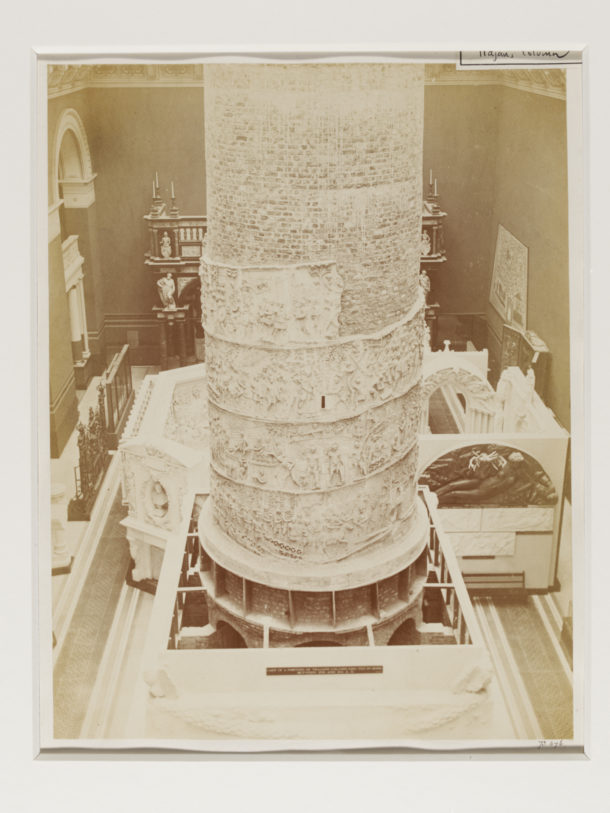
Many view copies as a threat to authenticity. Too many copies, so the thinking goes, will diminish the aura of the original. But putting copies in competition with their source material is a pointless game. The truth is, copies are the same, but different. They have their own history, and lead their own lives, separate from the original. It’s a concession that has to be made when considering rebuilding something that has been lost, or copying to mitigate the slow destruction of an original. The ship is the same but different.
An Endless Archive
Once you accept the copy as having its legitimate place, a world of opportunity opens up. For the Victorians, cast collections had their benefits, but were costly and a burden on space. Over the last few decades however, through exponential improvements in computing and digital scanning, it’s now possible to conceive of vast digital archives of material culture available in a few clicks. The trouble that Henry Cole had in physically bringing works to his public has now literally dematerialized. The Rijksmuseum took a bold step forward in this regard by digitizing and making freely available high-resolution scans of 150,000 pieces in its collection. Other museums are following suit as quickly as they can.
This does not preclude three-dimensional works either. 3D scanners have become increasingly powerful, allowing for the recording of entire buildings at impressive resolutions. Organizations such as the Zamani Project are using this technology to record much of Africa’s built cultural heritage, which has been relatively overlooked by older cultural institutions and museums who have focused primarily on Europe. In this sense, new technology is not just allowing for a new way to preserve heritage, but also helping to redefine the canon.
Other organizations are exploring how 3D scanning can be crowd-sourced, solving the immense logistical issue of scanning vast amounts of data across the globe. The Institute for Digital Archaeology, for instance, has embarked on its Million Image Database. By distributing 3D cameras to volunteers around the world, they hope to build up a vast collection of digital models of important heritage sites.
It’s also now possible to reconstruct 3D models of lost artefacts through 2D records. Project Mosul, now Rekrei, began as an initiative to source pre-existing photographs of objects destroyed during ISIS’s occupation of Mosul and recreate digital models. By collecting data from image sites like Flickr through the use of geotags, the organization is able to patch together working models of artefacts believed to have been lost forever. They have since expanded their remit, using satellite data to analyse the destruction of monuments in Nepal after the 2015 earthquake. The work of #newpalmyra approaches it from another angle. Working to reconstruct a complete 3D model of Palmyra as it might have looked originally, the organizers also use the project to rally an online community to raise awareness about the plight of #newpalmyra founder Bassel Khartabil, who since 2012 has been detained by Syrian forces.
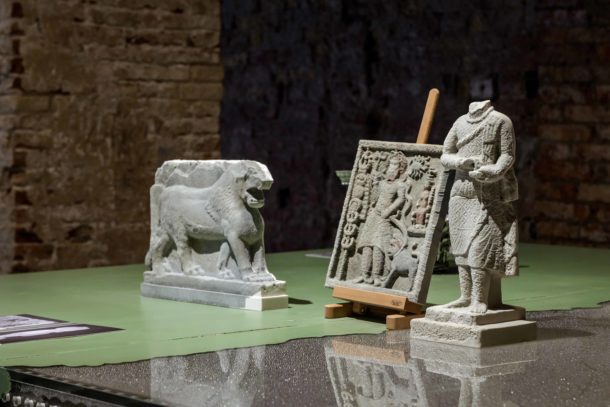
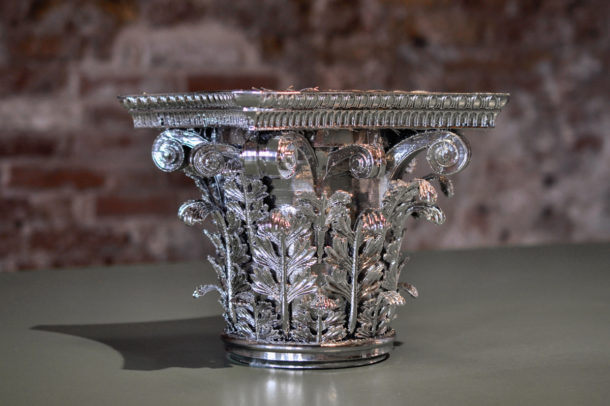
There still remain, however, many institutions that have taken a conservative tact with regards to 3D scans. The Neues Museum, who holds the bust of Nefertiti in their collection, has made a high-resolution scan of the object but has not released it publicly. For artists Jan Nikolai Nelles and Nora Al-Badri, this posed an ethical problem, as people have called for the object’s restitution to Egypt for decades. In reaction to this, the artists staged an intervention by surreptitiously acquiring their own 3d scan of the bust and then releasing it for free as a torrent file online.
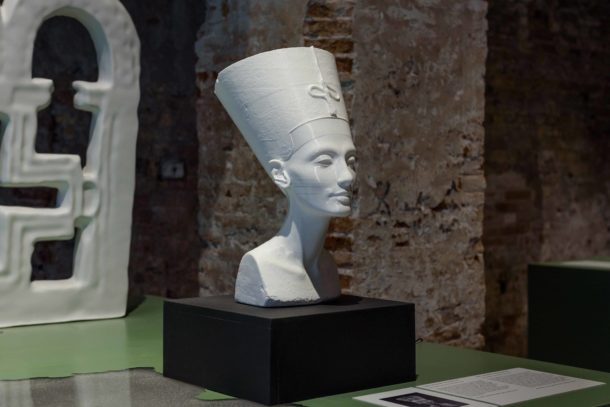
Indeed, through photogrammetry, a process where all one needs to make a 3D model is to take 30 to 40 photographs of an object from different angles and then feed it through software, it is increasingly difficult for museums to be gatekeepers of this information. When we were preparing for our exhibition A World of Fragile Parts, we collaborated with an organization, Scan the World, and discovered after-the-fact that they had already scanned and uploaded 300 sculptures from V&A galleries— simply by walking around the museum and snapping photos.
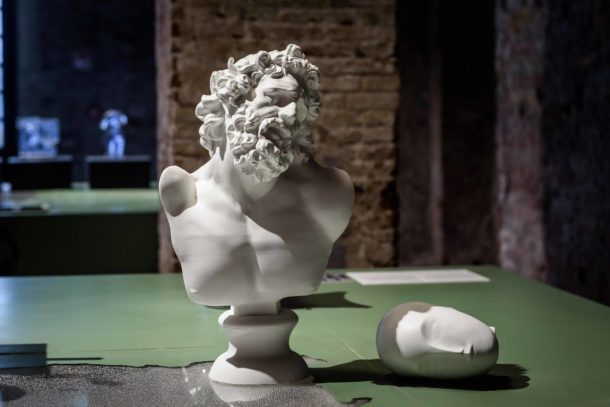
Perpetuation not Preservation
Preservation is often equated with keeping things the same, and so disregarded by many as a creative act. But preservation is never really maintaining stasis as things are always changing. By not just replicating something, but adding to it and modifying it in either large or small ways, what we are really talking about is perpetuating material culture rather than simply preserving it. Cultural perpetuation, is perhaps a better way to talk about our material culture because it openly encourages layering, interpretation, and an on-going dialogue about objects rather than a singular representation that has to be preserved forever.
To perpetuate material culture means to draw from the copy and add something new. For A World of Fragile Parts, we tried to imagine what a 21st-century cast court might look like, given the new tools and technology available. What we found were projects that went far beyond the preservation of culture, towards an idea of perpetuation, where new voices were added to old ideas. Factum Arte produced scaled reproductions Canova’s Pauline Bonaparte as Venus Victrix, in glass, wax and 3D printed resin, demonstrating the power of material transformations to create new expression. In a similar vein, Sam Jacob Studio scanned a migrant shelter in Calais and had a 1:1 copy made out of synthetic stone, monumentalizing an ephemeral yet poignant phenomenon of our current migrant crisis. Smout Allen and ScanLAB sought to record the decay of Robin Hood Gardens, by laser etching details of the building into crystal blocks, while David Gissen in ‘Some Small Leaks in Big Places’ explored the possibility of sound, recreating the acoustic qualities of famous buildings and feeding in a singular sound of dripping water.
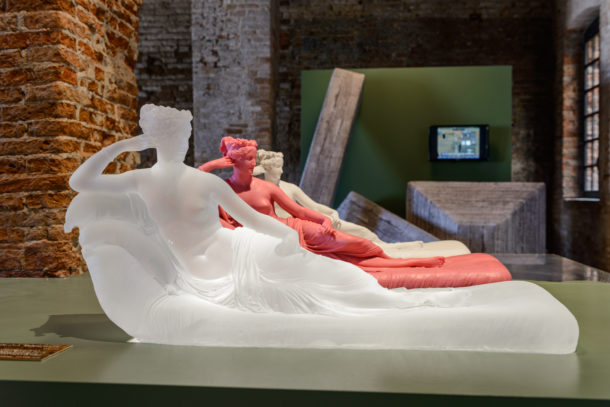
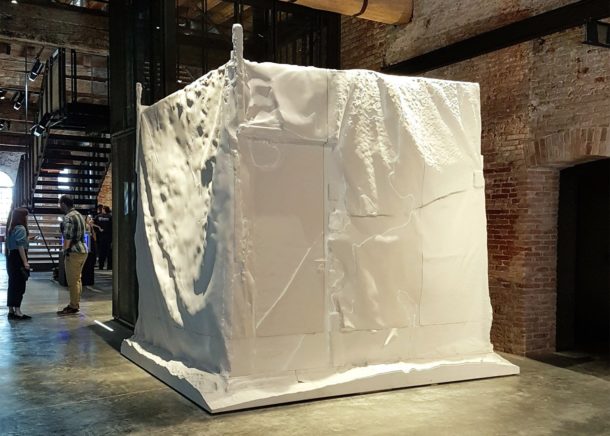
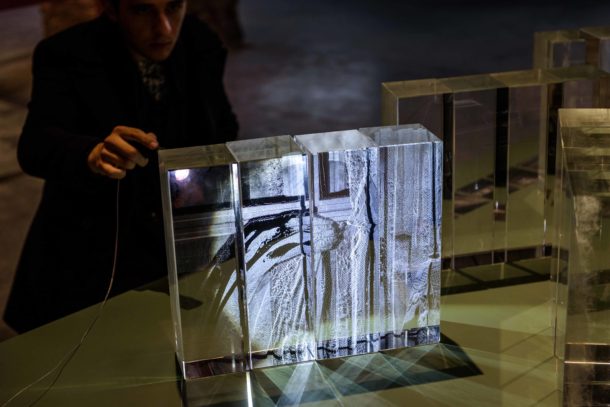
Other artists used copies to comment on the nature of decay and the potential for regeneration. Morehshin Allahyari used old documents to remodel figures from Hatra destroyed by isis in 2015, printing the objects in resin and embedding inside each of them a flash drive and memory card containing the image files, pdfs, and videos of her working process. Andreas Angelidakis flips the script by looking at the digital world as a world of decay. Pointing to social media sites like Second Life, which have already become obsolete, for Soft Ruin he reconstructs a model he created on the platform into a plush assemblage of parts.
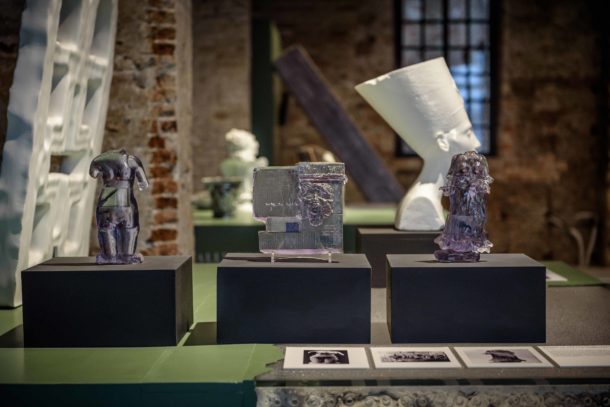
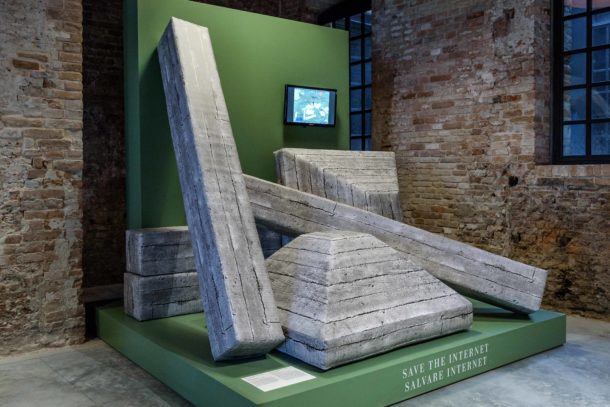
In one of the more poignant pieces, Forensic Architecture modelled and 3d printed four plume clouds from attacks by various aggressors in the Middle East. The work comes froma longer line of inquiry of theirs that uses architectural tools to model forensic evidence for human rights cases. But the clouds, once rendered solid and displayed side by side for comparison, concisely distil the terror of warfare in sculptural form.
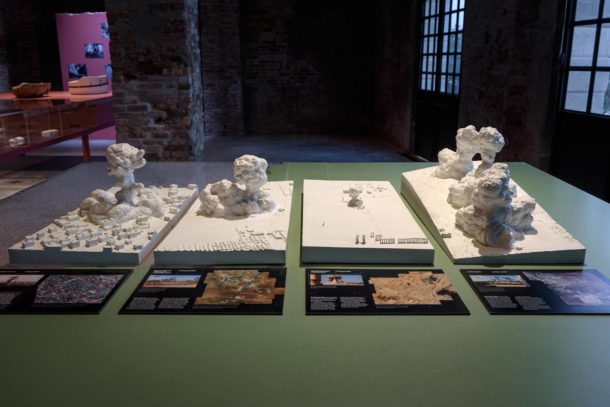
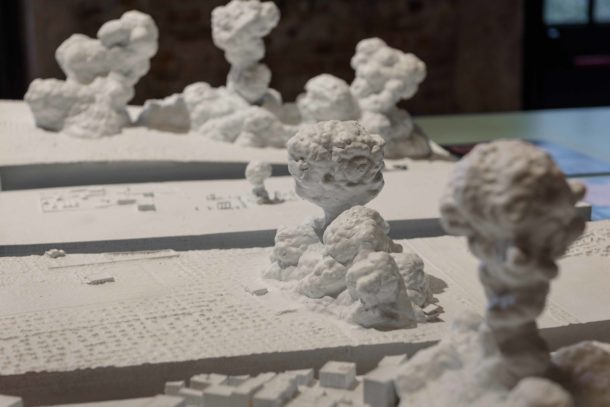
All of this is not to challenge the profound aura of original works of art. There is no evidence of this declining in our popular imagination. In fact, given the choice between originals and copies, the original always wins. In a recent study, a focus group was asked to imagine that the Mona Lisa had been reduced to a pile of ashes, but a perfect copy existed. They had a choice to see either the ashes or the copy, and 80% still chose the ashes, even though hypothetically it bore absolutely no resemblance to the original work itself, and was indistinguishable from any other pile of ashes. Applying this bias literally across the preservation landscape of course would yield horrific results. Roofs would be left to rot, paintings left to fade away, because any addition, change, or restoration, would be an infringement on the aura of the original. In a fragile world however, where all things eventually fade away, there is a clear choice to be made: we can either embrace the creative potential of copies, or learn to love a pile of ashes.
